On foot, fat-tire snow bike, and snowshoes, I traversed sites steeped in history and ancient religious beliefs while savoring extraordinary snowy scenery last February in Japan. Embark on these snow activities and soak in Aomori Prefecture, Japan.
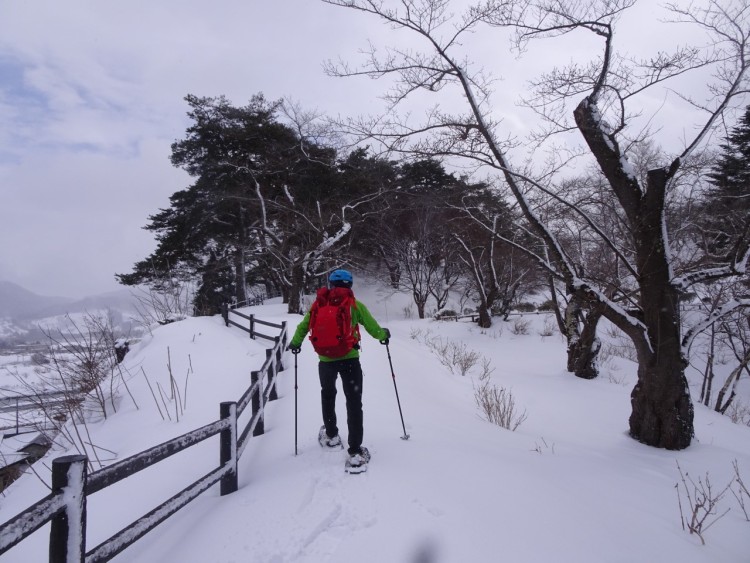
Exploring the Aomori Prefecture of Japan by snowshoe is one of the many ways to see historical parks and sites steeped in ancient history and religious beliefs. Photo: Greg Goodmacher
Some of the links in this article may contain affiliate links. When you purchase using these links, part of the proceeds go to Snowshoe Mag. Additionally, as Amazon Associates, we earn from qualifying purchases. Please see our disclosure for more details.
Sacred Frozen Waterfall
A waterfall freezes into a mysterious column of ice on the edge of the border of the Shirakami Sanchi World Natural Heritage Site in Aomori Prefecture. According to millennia-old beliefs, the 33-yard-high Niogataki Waterfall and nearby trees and shrines harbor holy spirits called kami. Niogataki Waterfall freezes into a solid pillar during particularly long, cold winters. A female shaman examines the ice during a local festival and foretells the coming harvest, an ancient tradition continuing in Nishimeya, Aomori.
I visited this holy location in the late afternoon before a snowshoe and snow bike tour planned for the following day. Climbing a short steep trail into a secluded valley, I found towering cedar trees nearly encircling the rocky face of a ninety-degree cliff dripping giant icicles. Long ago, someone built boxlike Shinto shrines with religious figurines into a hollow beneath the cliff lip. Water sprinkled off the ledge of the v-shaped cliff, falling toward a pool below. From that pool, a blue-ice-tinged pedestal of ice grew. Moreover, the top of the ice looked like a lotus flower.
My traveling companion and I were alone in this natural holy cathedral. Silence blew like a breeze through the forested valley. We cautiously followed a slippery walking trail that zigzagged behind the waterfall to a precarious wooden platform in front of the tiny shrines. From this vantage point, we gazed downward at the growing ice pillar. A couple of other visitors approached the frozen waterfall. From the high platform, they appeared like miniature dolls.
I neither believe in nor follow any particular religion, but in places of extreme natural splendor, an indescribable sense of belonging, awe, and thankfulness for nature floods my soul.
Read More: Remote Snowshoeing in Nagano, Japan
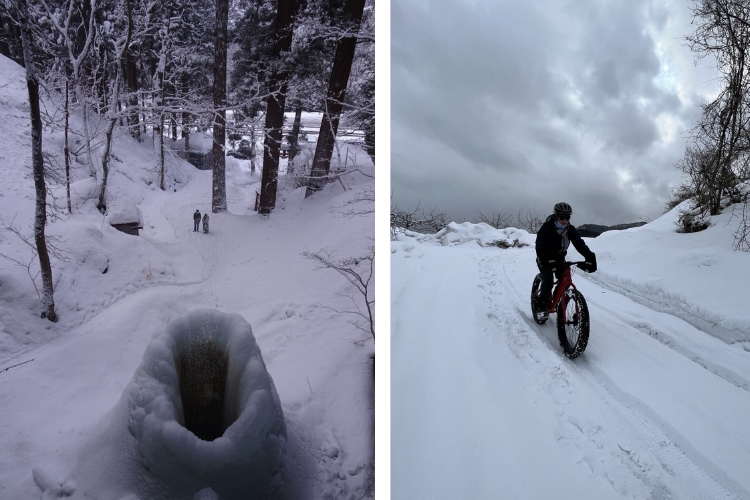
L: Gazing down from the top of the waterfall is part of nature’s splendor. R: Exploring the snowy landscape by bike is a great way to explore the scenery. Photos: Greg Goodmacher
Snow Bike and Snowshoe Tour
The next day, as light snow fell upon my companion and me, we met BBB Aomori Tour Guide Kazuo Hanada and his assistant Yumiko Shimoyama at a local farmer’s market and hot spring facility near the center of Owani Onsen, Aomori. Three bicycles sprinkled with fresh snowflakes waited next to the support van. These bikes were part of the Winter Apple Garden Tour.
The KHS snow bikes fitted with ultra-fat tires (4-inch by 26-inch) maintained stable balance on the icy terrain, so I felt much safer on the frozen landscape than I would if I were riding a road bicycle, cross bike, or mountain bike.
Cycling Owani Onsen
Feeling excited, I pedaled my ride behind outdoor guide Hanada as he began the tour with a scenic cruise through central Owani Onsen. We rode through the barely trafficked streets past mostly one- and two-story buildings topped with snow. However, I probably would have missed the tiny, unassuming train station if not for a giant statue of an alligator standing with skis next to a free public hot spring for soaking feet in front of the station.
One of the Japanese kanji characters used in the name Owani means alligator, and Owani boasts one of the oldest ski resorts in Japan. Souvenir shops sell t-shirts with images of alligators and hot springs. Though alligators do not exist in Owani Onsen, other than in stories and on merchandise, there are plenty of hot springs.
Read More: Winter Canoeing, Trekking, and Hot Springs in Aomori, Japan
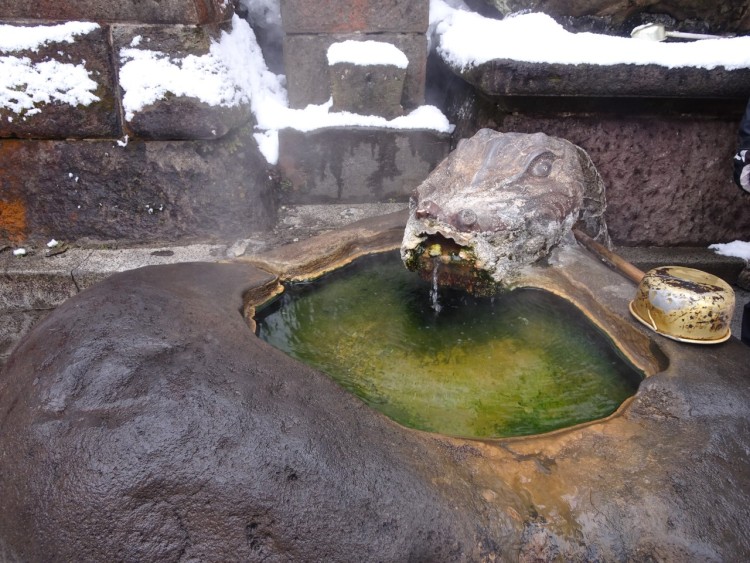
The Dragon Ashiyu pours thermal water to warm up in near-freezing temperatures. Photo: Greg Goodmacher
We stopped to thaw our hands at Dragon Ashiyu (ashiyu means foot bath), where thermal water was pouring from the mouth of a stone-hewn dragon into a rock basin. The dragon’s head was warm, and the discharged water felt fiery. In the near-freezing temperature, the sensation increased the circulation to my almost-numb fingers. Moreover, the town was silent except for the loud whoops and moans of a flock of swans swimming in a nearby river of crystal snowmelt. Only the swans and three nuts on snow bikes were outside.
From Owani Onsen, we bicycled on a mostly white road, entering a land of rolling white hills speckled with mostly family-owned apple orchards. Tendrils of snow snaked around the thick solid branches. The view was relaxing until an unexpected blizzard slammed into us. Then snowflakes violently blew into my naked eyes; visibility decreased to a few yards. My fingers grew numb. I was on edge regarding continuing.
Luckily, we soon passed one of many locations where Ms. Shimoyama waited for us in the support van. She handed me heating pads to put in my gloves, and I covered my eyes with a pair of goggles. Then, I could cycle at ease despite the storm.
Read More: Snowshoe Education and Adventure in Matsudai, Niigata
Snowshoeing Through History in Daibutsu Park
About five kilometers from our starting point, we met the support van conveniently parked about fifty yards from the park where we would snowshoe. My companion received a pair of MSR snowshoes from BBB Aomori while I grabbed my Atlas Montane snowshoes from the van. By then, the snowstorm had passed, and only a light snowfall drifted around us.
Walking from the van to Daibutsu Park, we passed through a scene of Aomori winter life. Probably in their late sixties, two ladies were chatting while holding snow shovels in the middle of the street between their homes. Meanwhile, Japanese folk music blasted from one house.
Our guide led as we climbed the trackless trail, ascending the first hill within the park grounds. We passed bare-leafed cherry trees, perhaps anticipating the warmth of spring. Instead, pillows of snow clung to the thick brown branches instead of the white and pink flowers that invite picnics and flower viewing parties and then fall like snowflakes. Desiccated hydrangea stalks and flowers randomly pierced the powder lying atop the snowpack. The small community of houses on the park border became smaller while the vista expanded.
The view from the first plateau made us pull out our cameras. Sparkling with light, the glittering Hirakawa River was an irregular line separating two white regions of flat farmland and rolling hills. Next, we saw distant mountains deluged with snow, probably the storm that had earlier swept over us.
From somewhere out of sight, the clanging of railroad crossing bells broke the silence. Mr. Hanada pointed toward a silvery metallic train bridge crossing the river. Moments later, we heard and then saw the two-car-only passenger train that connects this region’s rural communities. It rolled across the river, crossed through orchards of leafless apple trees, and disappeared into the white mist of falling snow.
There was a peacefulness to the park despite its violent history. Deep underground beneath the soft snow, the yet-to-sprout-fresh spring greenery, and the roots of old cherry trees, one might be able to find broken arrows and spears from a brutal battle between two competing samurai groups, the Nanbu and Tsugaru clans. Though the Nanbu had a fortress on the high hills, the Tsugaru clan won the ferocious battle.
Read More: Ascending Spiritual Mountains in Tottori, Japan
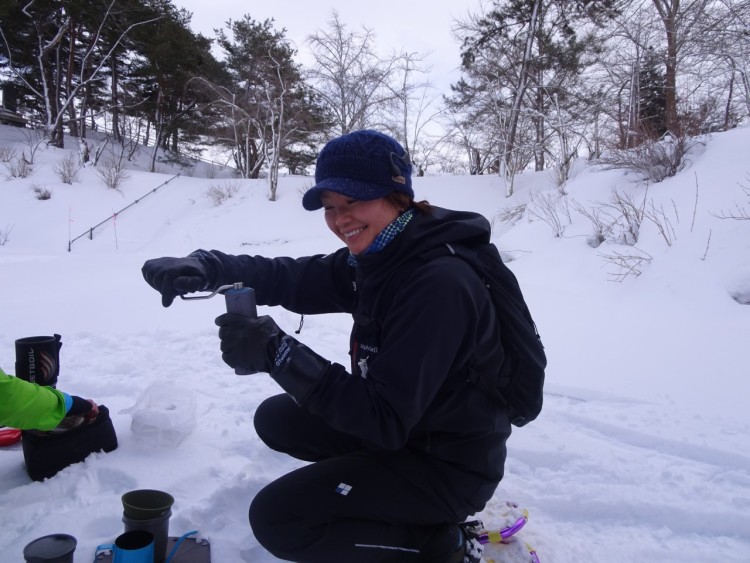
Taking a break from snowshoeing while at the ancient battleground for freshly-brewed coffee. Photo: Greg Goodmacher
This ancient battleground was also fantastic for enjoying freshly brewed coffee. Our guide suggested a break. I expected hot coffee from a thermos. However, while squatting on the snow, Ms. Shimoyama ground newly roasted coffee beans with a portable hand-powered grinder as Mr. Hanada boiled water with a camping stone. We enjoyed superb freshly brewed coffee and traditional Japanese sweets in the middle of a snowy park. They sometimes prepare hot sandwiches for guests.
After this break, we continued snowshoeing through the park grounds. Interwoven rabbit, marten (spelling), bird, and fox tracks told natural history stories of the animals inhabiting the park in winter.
I discovered an arrow-shaped wooden sign with the words Thirty-three Kannon and asked Mr. Hanada to show me what that was. As a result, I experienced a pilgrimage route. We continued uphill toward the path that would take us up and down a zigzagging path to thirty-three statues of a revered female Buddhist on the way to becoming a Buddha.
Read More: Japanese Bonfire Festival and Snowshoeing on Mt. Gozu
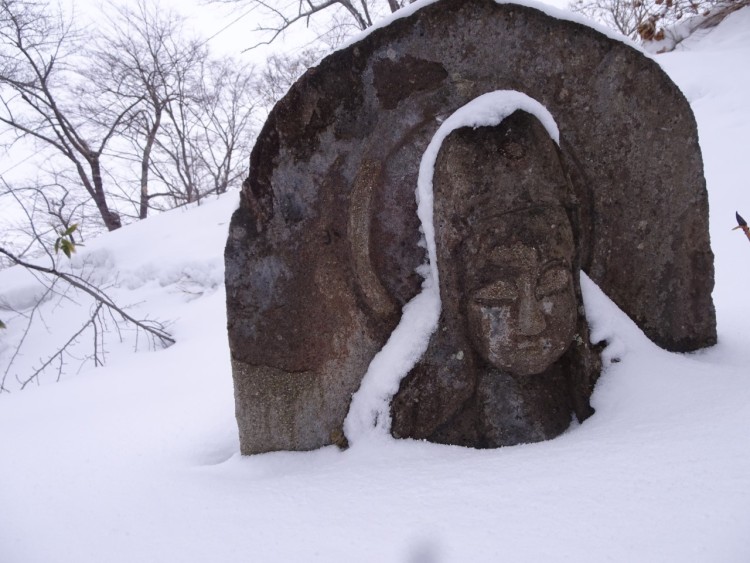
One of 33 statues of Kannon, representing mercy and compassion. Here, cold but compassionate. Photo: Greg Goodmacher
In Japan, Kannon represents mercy and compassion. There are many sacred pilgrimage routes, both long and short, across Japan that take walkers to view, pray, and or show respect to thirty-three different figures of Kannon. In Japanese culture, Kannon can appear in thirty-three different shapes. For instance, some images depict her with a thousand arms or a horse’s head. But usually, she looks calm and gentle. Unfortunately, because of the snow depth, we could not see all of them.
Apres Away
We snowshoed back to the bicycles and returned on snowy roads between apple orchards to Owani Onsen. Along the way, we met one long-haired fox in the middle of an unplowed road. Our eyes met briefly before the fox bounded into the woods and disappeared.
Our guide led us on bikes to Owani Onsen’s excellent Fujiya Hotel. Here, we could finish by soaking in a natural outdoor hot spring on the hotel grounds. It was one of the best outdoor springs I have experienced recently. Hot water heated my body, steam wafted off the surface of the thermal water, and gentle snowflakes cooled my exposed skin. Then, we followed that with a full-course Japanese dinner, a perfect end to a physically and culturally enriching snowshoe experience.
Getting to the Owani Onsen Station from Tokyo
From Tokyo, fly to Aomori Airport. Take the Aomori Airport Limousine Bus to the Hirosaki Bus Terminal. Walk two minutes to the Hirosaki Train Station and board a local train to Owani Station. A taxi is helpful for particular locations within the center of the onsen village. Some hotels may pick you up if requested in advance.

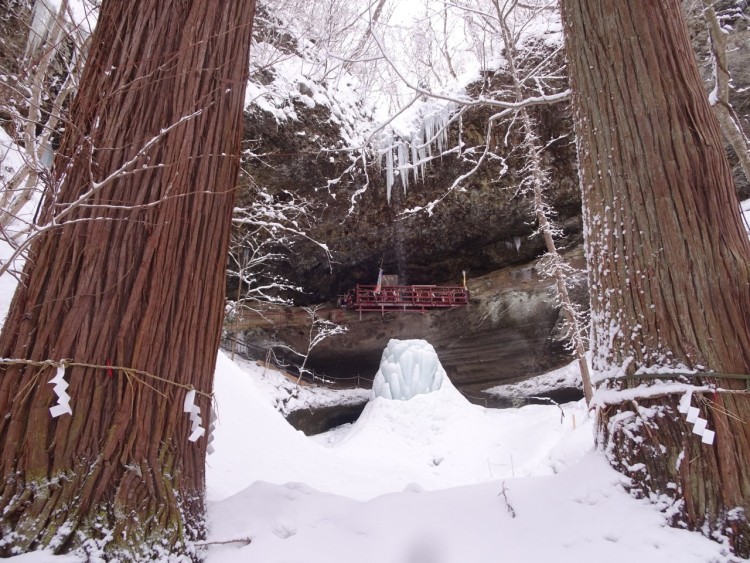
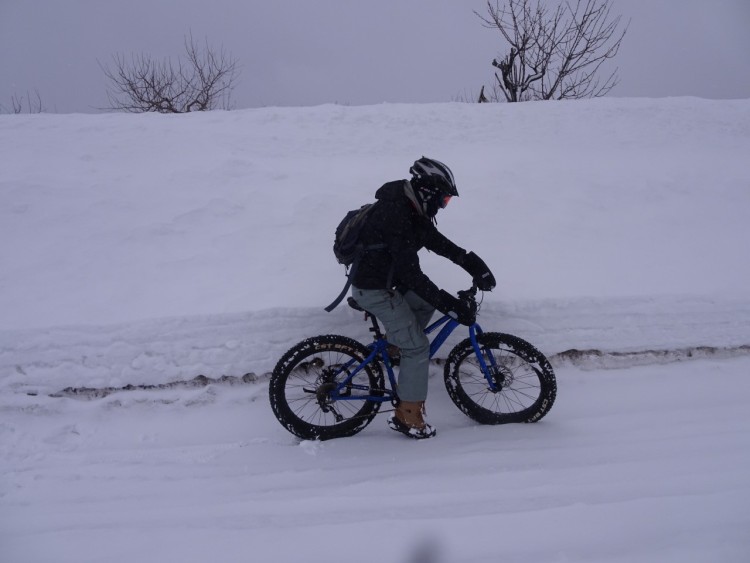
露天風呂-750x422.jpg)
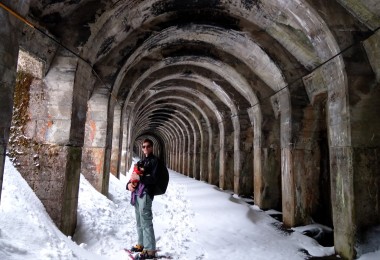
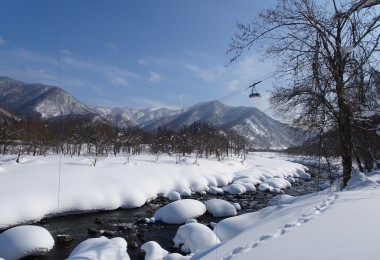
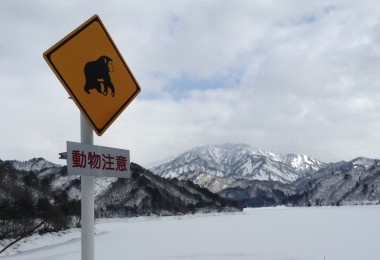
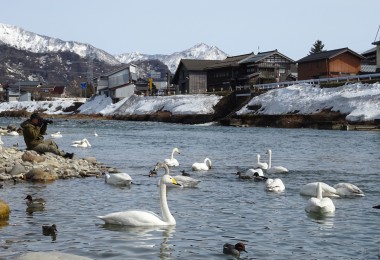

Leave a Comment